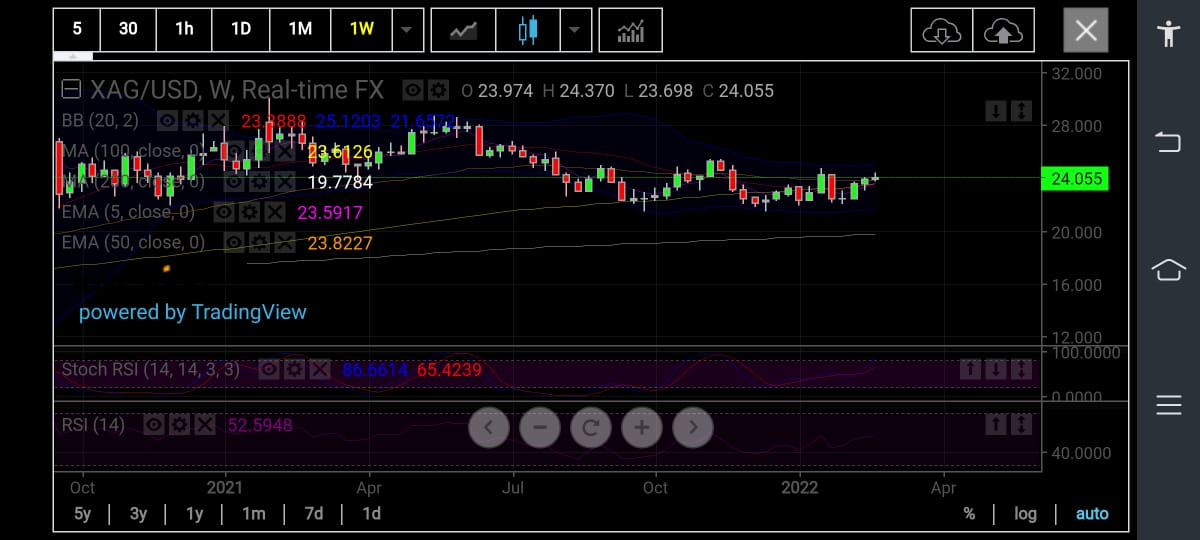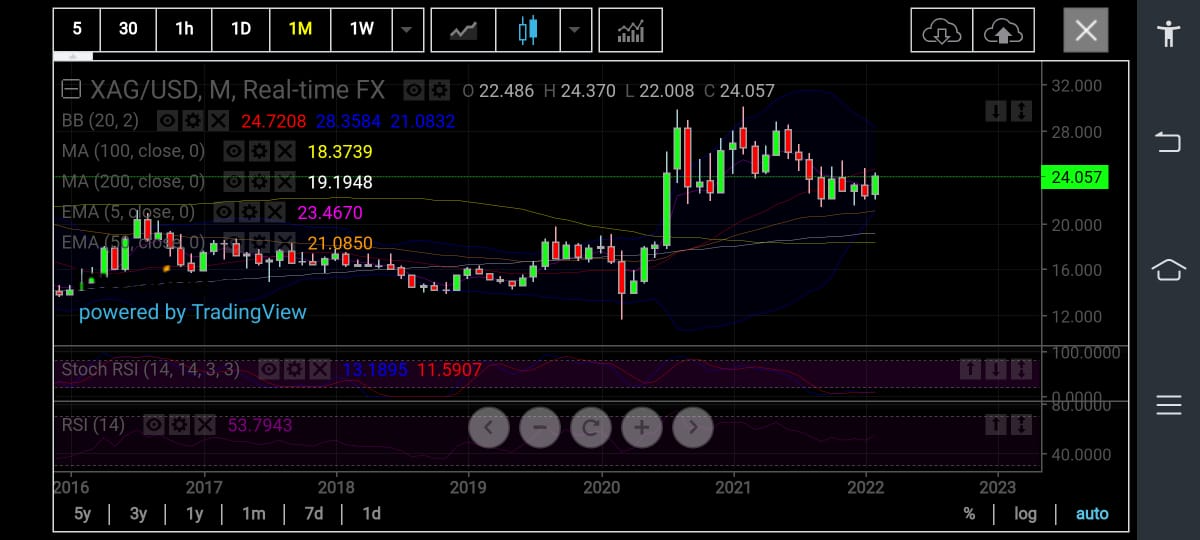Silver prices are up 8% for February, heading for their best month in five.
Global demand for silver is also on the rise and could reach a record this year, according to Edmund Moy, former director of the US Mint and a senior retirement strategist specializing in precious metals at the US Money Reserve in Austin, Texas.
But until a month ago, silver seemed to be in the dumps, trailing gold, palladium and platinum.
In fact, even with February’s rally, silver at times felt like the “forgotten stepchild” of the precious metals bucket—rarely eliciting the kind of excitement found in gold, which is having a blockbuster year as an inflation hedge and a safe-haven buy amid the Russia-Ukraine standoff.

Charts courtesy of skcharting.com
The problem with silver though is while it’s officially clumped into the precious bucket along with gold, palladium and platinum, it really is more of an industrial metal in terms of its applications and demand.
And industrial demand for silver has been a little slow to take off this year as sectors of the US and global economy continued to suffer from the supply chain disruptions caused by the two-year-long coronavirus crisis.
Also, prices of silver are typically “joined at the hip” with gold, rising and falling in tandem with the yellow metal.
Silver trades at a fraction to the price of gold and is often called the “poor man’s gold”—so much so there’s even a gold-silver ratio that serves as a benchmark for the valuation of silver.
Seldom does silver break out or plunge on its own without gold rallying or falling as a catalyst. But gold can, and has, traded independently of silver, literally outshining it in many trading sessions.
For instance, gold surged to eight-month highs above $1,900 an ounce in recent days, from a combination of US inflation growing at 40-year highs and the alarming acceleration of the crisis in Ukraine. Silver, in comparison, hit just a five-week peak above $24 an ounce this week. That brought the gold-silver ratio to 1:79, meaning an ounce of gold could be used to purchase 79 ounces of silver.
Despite all this, a “compelling argument can be made that 2022 will be a good year for silver,” said Moy, the former US Mint director, in a Barron's interview published last week.
He added:
“As the global economy recovers from the pandemic, expect to see silver demand rise from the industrial sector.”
Total global silver demand is forecast to climb by 8% to a record high of 1.112 billion ounces this year, according to data from the Silver Institute also published by Barron's.

Based in part on analysis from precious metals research consultancy Metals Focus, the Silver Institute said that the “exceptionally promising” outlook for silver demand is driven by record silver industrial fabrication, which includes electrical and electronic applications, as well as green technologies.
The Silver Institute forecasts growth of 5% this year for global industrial silver demand to a new high of 552 million ounces.
Industrial demand is half of total demand for silver, and should be responsible for about half of the price movement, says Robert Minter, director of ETF investment strategy at Aberdeen Asset Management. The other half of demand comes from jewelry and investment use, where drivers are similar to gold, he says.
“Because of the demand sources, silver can be thought of as half gold, half copper,” says Minter. “Yet when we compared returns since the end of 2020, copper is up 28%, gold is down 2%, and silver is down 12%.” That implies silver prices should be much higher, he says.
For silver just to catch up to half of copper’s performance, that would imply a silver price near $25.50 an ounce, says Minter. Based on Tuesday’s peak of 24.43 on New York’s COMEX futures trade, copper has to gain another 4.4% to catch up with just copper.
More than 50% of silver’s demand originates from industrial use. As a malleable metal, it is just as good as gold for jewelry making. It is also a good conductor of electricity, and used extensively in the manufacture of electronics components.
The transition to clean energy is expected to drive physical demand for silver in the coming years, particularly for connections in electric vehicles and for components within solar panels.
The rollout of fifth generation (5G) telecom networks is also set to become a growing source of demand.
Michael Cuggino, president and portfolio manager of the Permanent Portfolio Family of Funds, told Barron's that 2021 served as a “basing and consolidating year” that provides a “good entry point for a long-term investor” in either silver or gold. Both precious metals saw price falls last year as inflation began to emerge.

Still, silver futures have been generally stuck in a less than $5 an ounce trading range since August.
Demand is expected to come from both traditional and cyclical businesses, as well as from emerging green industries—providing a “strong long-term demand picture for industrial use,” says Cuggino.
Likely triggers for a breakout move this year include geopolitical and monetary concerns, inflation issues, and growth in silver demand, he says.
The Silver Institute expects physical silver investment demand to rise by 10% in 2022 to 290 million ounces, according to executive director Michael DiRienzo.
Investors are already buying silver. Moy points out that sales of American Eagle silver one-ounce coins at the US Mint climbed from a pre-pandemic level of 14.9 million in 2019 to 28.3 million last year.
Silver mining stocks and exchange-traded funds also have their place in a “savvy investor’s toolbox, but owning the physical metal gives the investor a tangible asset without having to factor in management,” he says.
If inflation remains “high and persistent, expect more investors to hedge their portfolios with some silver,” Moy says, and those looking to mining stocks, ETFs, or owning the physical metal will have to decide what works best in their portfolio.
“Stocks and ETFs are convenient, but their performance is dependent on more than just spot prices,” and when it comes to ownership of the physical metal, storage and portability are key concerns, he says.
So, what do silver’s price technicals say?
“The short term price action indicates that silver is struggling to clear the 200-Day Simple Moving Average of $24.20,” Sunil Kumar Dixit, chief technical strategist at skcharting.com, said in his analysis of the spot silver chart.
Dixit said on a weekly chart, the 100-week SMA of $23.60 and the 50-week Exponential Moving Average of $23.80 have been supportive for maintaining the upward move in silver.
“A sustained move above the 200-Day SMA of $24.20 will clear the way for next resistance of $24.75,” he added. “However, failure at $24.20 may push prices down to retest $23.80 and $23.60.”
Disclaimer: Barani Krishnan uses a range of views outside his own to bring diversity to his analysis of any market. For neutrality, he sometimes presents contrarian views and market variables. He does not hold a position in the commodities and securities he writes about.
